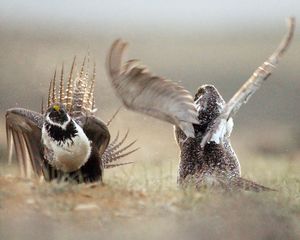Idaho plan seeks to protect sage grouse habitat
THREATENED SPECIES -- The effort continues to avoid the restrictions that would go along with having an endangered native bird on western prairies.
The Idaho Department of Lands has put forward a draft plan to protect sage grouse habitat on state endowment land as part an effort to avoid a federal listing of the bird under the Endangered Species Act.
The state agency that manages more than 2.4 million acres last week released the 33-page document that’s intended to guide activities on the nearly 700,000 acres of state land deemed important habitat for the football-sized bird, according to the Associated Press.
The plan has critics, especially regarding its guidelines for grazing.
The state agency is taking comments on its Proposed Greater Sage-Grouse Conservation Plan through March 2. Later in March, the Idaho Land Board and the Oil and Gas Conservation Commission will vote on whether to approve the plan.
According to the AP:
The plan aims to protect habitat by creating enforceable stipulations in state leases, permits and easements. The U.S. Fish and Wildlife Service will likely take Idaho’s plan into consideration when the agency makes a decision about listing sage grouse. That decision is expected in the fall.
“What the Service is looking for is mechanisms that provide certainty,” said Tom Schultz, director of the Idaho Department of Lands. “Just saying we’re going to do something without having mechanisms to make sure they get done won’t work.”
Idaho’s plan covers an array of activities that occur on state lands. Those include solar, wind and geothermal energy projects as well as oil and gas exploration and development. Mining and grazing are also covered as is the granting of rights of way. Also included are fire prevention and mitigation efforts to minimize loss of sage grouse habitat.
Agency officials said the plan complements Idaho Gov. C.L. “Butch” Otter’s sage grouse plan he submitted for federal officials to consider as the government eyes protections. A listing could have ramifications for agriculture and energy, possibly damaging the economies of the 11 Western states where the bird resides.
In Idaho, about 10.5 million acres are designated either core or important sage grouse habitat. Of those 10.5 million acres, about 700,000 acres are Idaho endowment lands, or about 6.5 percent.
While Idaho endowment land with sage grouse habitat represents a small percentage of sage grouse habitat overall, the 700,000 acres nonetheless represent 44 percent of endowment rangeland in Idaho. So a sage grouse listing would likely decrease how much money the state can produce from its endowment rangelands.
The money generated from endowment land mostly goes to public schools. The Idaho Department of Lands is tasked with producing the most amount of money from the endowment land over the long run. That means the state agency is now trying to find a way to meet its mandate while also protecting sage grouse habitat.
“It’s a balance,” Schultz said, “but we think in the long run avoiding a listing is a good thing. If the bird gets listed, we will still have to have a strategy where we do not take birds.”
Schultz said his agency doesn’t have authority over private land but the agency’s plan contains conservation measures for private landholders that will be voluntary. A listing of sage grouse would also require private land owners to avoid activities that harm the bird or its habitat.
Travis Bruner of Western Watersheds Project, a conservation group based in central Idaho, said the plan lacks credibility when it comes to cattle grazing.
The plan states that, “Grazing has been determined to not be a primary threat to sage-grouse in Idaho.” The plan also calls for targeted grazing to reduce fire fuels and the use of grazing to help restore areas burned in rangeland fires.
“They seem to deny that there are any negative impacts at all on sage grouse due to grazing,” Bruner said. “That’s contrary to science.”
The state agency is taking comments on its Proposed Greater Sage-Grouse Conservation Plan through March 2. Later in March, the Idaho Land Board and the Oil and Gas Conservation Commission will vote on whether to approve the plan.

